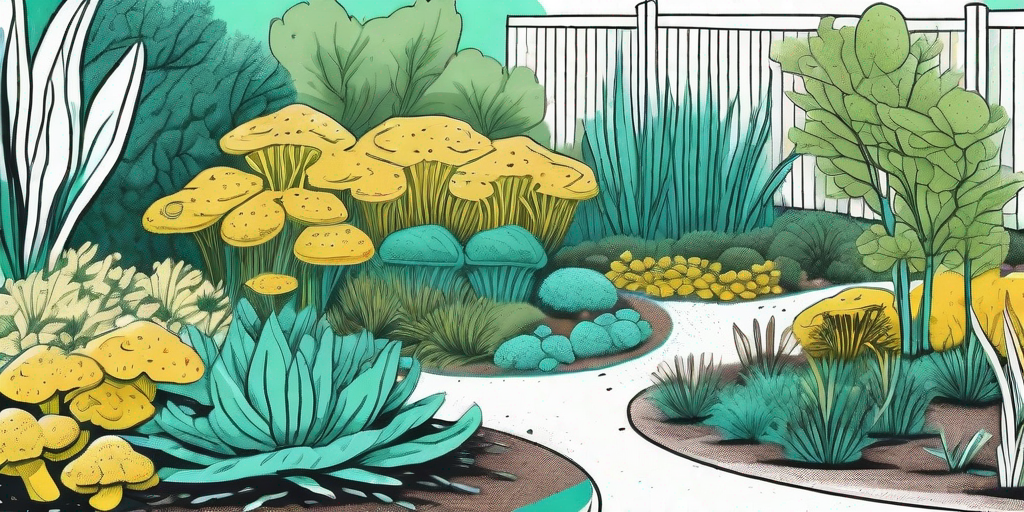
Mulch, that wonderful layer of organic material we spread over the surface of our soil, is a gardener's best friend. It retains moisture, suppresses weeds, and improves soil health. But, like that one friend who always seems to bring uninvited guests to parties, mulch can sometimes harbor unwelcome fungi. One of the most common is yellow fungus, a mold that can turn your beautiful garden into a scene from a horror movie. But fear not, dear gardener, for we have the tips and tricks to keep your mulch mold-free and your garden party fungus-free.
Understanding Yellow Fungus
Before we dive into the nitty-gritty of mold prevention, let's take a moment to understand our enemy. Yellow fungus, also known as slime mold, is a type of fungus that thrives in moist, shady areas. It can appear as bright yellow spots on your mulch, and while it's not harmful to plants, it's certainly not a pretty sight.
Yellow fungus is like that annoying neighbor who shows up uninvited and refuses to leave. It's stubborn, persistent, and can be a real pain to get rid of. But with the right knowledge and tools, you can send this unwelcome guest packing.
What Causes Yellow Fungus?
Yellow fungus is caused by a variety of factors, but the main culprits are moisture and lack of sunlight. Just like that one friend who always seems to be at the beach, yellow fungus loves to bask in the damp and dark. If your mulch is constantly wet and doesn't get much sun, you're basically rolling out the red carpet for this pesky fungus.
Another factor is the type of mulch you use. Some types of mulch, like wood chips and bark, are more prone to fungus than others. So if you're using these types of mulch, you might want to keep an extra eye out for any yellow spots.
Preventing Yellow Fungus
Now that we know what causes yellow fungus, let's talk about how to prevent it. After all, prevention is better than cure, right? Here are some tips to keep your mulch mold-free.
Choose the Right Mulch
As mentioned earlier, some types of mulch are more prone to fungus than others. So if you want to reduce the risk of yellow fungus, choose your mulch wisely. Straw, grass clippings, and compost are less likely to harbor fungus, so consider using these instead of wood chips or bark.
Also, consider the color of your mulch. Dark-colored mulch absorbs more heat, which can help to kill off any potential fungus. So if you're choosing between dark and light mulch, go for the dark side. Your plants will thank you.
Monitor Moisture Levels
Remember, yellow fungus loves moisture. So if you want to keep it at bay, you'll need to monitor your mulch's moisture levels. This doesn't mean you should let your mulch dry out completely - after all, one of the main benefits of mulch is its ability to retain moisture. But try to avoid overwatering, and if possible, water your plants in the morning so the sun has a chance to dry out the mulch.
Also, consider using a moisture meter. These handy devices can tell you exactly how moist your mulch is, so you can adjust your watering schedule accordingly. It's like having a personal assistant for your garden, but without the hefty salary.
Dealing with Yellow Fungus
So you've done everything right, but yellow fungus has still managed to crash your garden party. Don't panic - there are ways to deal with this unwelcome guest.
Remove Infected Mulch
The first step is to remove any mulch that's been infected with yellow fungus. This will help to prevent the fungus from spreading to the rest of your garden. Just be sure to dispose of the infected mulch properly - you don't want to accidentally spread the fungus to other parts of your yard.
Once you've removed the infected mulch, replace it with fresh, fungus-free mulch. And remember to monitor the moisture levels to prevent the fungus from returning.
Use Fungicides
If the yellow fungus is particularly stubborn, you might need to bring out the big guns - fungicides. These chemicals can kill off the fungus and prevent it from returning. Just be sure to follow the instructions on the label, and use them sparingly - you don't want to harm your plants or the beneficial insects in your garden.
Also, keep in mind that fungicides are a last resort. They should only be used if other methods have failed, and they should always be used responsibly.
Frequently Asked Questions
Is yellow fungus harmful to plants?
No, yellow fungus is not harmful to plants. It's just an eyesore. But if left unchecked, it can spread and take over your garden, which can make your garden look less than appealing.
Can I prevent yellow fungus by not using mulch?
While it's true that yellow fungus is more common in mulched areas, this doesn't mean you should stop using mulch. Mulch has many benefits for your garden, and with the right precautions, you can prevent yellow fungus from appearing.
What if I can't get rid of yellow fungus?
If you've tried everything and the yellow fungus still won't go away, it might be time to call in a professional. A professional gardener or landscaper can help you deal with the fungus and give you tips on how to prevent it in the future.
Conclusion
Yellow fungus might be a nuisance, but with the right knowledge and tools, it's a manageable one. By choosing the right mulch, monitoring moisture levels, and dealing with any outbreaks promptly, you can keep your mulch mold-free and your garden looking its best. So say goodbye to yellow fungus, and hello to a beautiful, healthy garden.















